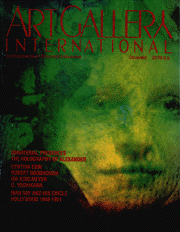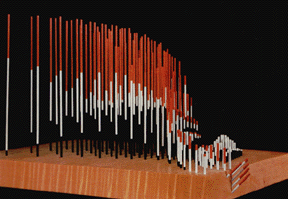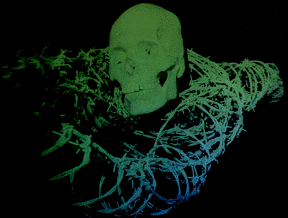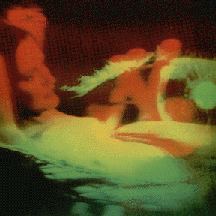

As holography moves out of the realm of novelty and into the arena of fine art, its legitimacy as an expressive medium becomes evident. The technically-based imaging process based on the power of laser light only progresses beyond a fascinating oddity because its aesthetic efficacy becomes obvious in the hands of poetically skilled practitioners.
Alexander is an artist lending aesthetic legitimacy to holography. In numerous works, he has used the inherent parameters of the process to set it alongside historically venerable media such as oil painting and bronze sculpture. The British-born artist has worked in these traditional media, and at the end of the 1970s, created some of the largest bronze sculptures of modern times, particularly his The Great Tower in Leicestershire, Great Britain.
A retrospective exhibition of Alexander's work from the 1980s that has been touring The Museum of Contemporary Art in Sao Paulo, Brazil, The Museum of Fine Art in Santiago, Chile, and, early in 1990, The Modern Museum of Art in Santa Ana, California, documents the artist's transition from traditional media to holography, and the startling advances he has made in redefining the look of what is considered to be high art.
The artist himself explains the transition . After having had a career making more classical pieces, he begins, I woke up one morning with an idea that I would do something completely different from anything that I've done and anybody else has done.' He had been reading P.D. Ouspensky's challenging Tertium Organum in 1980 when he became intrigued by the concept of four-dimensional space and its expression in a physical work of art. After a trying experimentation period of six months, he made a breakthrough.
I call them four-dimensional sculptures, because if you walk around them or if they go around, you can see shapes inside them that don't really exist. And so I changed over to making this more abstract and very different kind of work. The four-dimensional sculptures consist of painted rods vertically placed on a base. As the viewer moves around the work, a series of shimmering, kinetic illusions are formed by the lateral motion.

Alexander executed the four-dimensional sculptures on a monumental scale to good effect and they were well received. But his attempt to document them led to an odd discovery. When I made my previous work, I photographed it and sent the photos to galleries all over the world that were representing me so they could see whether they liked the work or not. I had a good communication with the galleries just using ordinary photographs. However, when I made the four-dimensional sculptures and photographed them, the essence was lost. They looked dead. In order to see them, you needed movement parallax.
Since I needed some sort of record I could send to art galleries in various countries, I decided that I had to use either video, movies or holograms. I tried holography because nobody has ever had a subject before that requires movement parallax. First encountering holography at a one-day seminar at Goldsmith's College in South London, Alexander subsequently obtained a fellowship upon returning to his residence in Sydney, Australia, at the National Measurement Laboratory, where he worked with Dr. Hariharan, one of the leading scientists in the field and an optical engineer.
Dr. Hariharan taught me the fundamentals of the holographic process, explains Alexander, and he taught me how to go about pushing the boundaries of the process out. I couldn't make the sort of works that I wanted with the limitations that existed at the time. Now, when I started, the idea was simply to make a record of pre-existing sculptures which I could send to galleries. But as soon as I started making holograms I thought the process had the potential to become an art medium in its own right. But I had to overcome some of the limitations of the process. I saw that I could use it as an art medium just as I had used marble or bronze.
The first holograms were really quite small. And I made quite a number of them. However, I decided that I actually wanted to use the process itself and create sculptural works in the process, and not make pieces of sculpture and holographically record them as I had made photographs of three-dimensional work. I could see that the potential of holography was such that it was really prostituting it to use it for mere documentation.
So I made work in the beginning which developed from the four-dimensional sculptures, but which were really created for the holographic process. These works Alexander called holosculptures, and, Iike the four-dimensional sculptures which preceded them, they utilized a variety of shapes that exploited dimension and movement parallax.
The retrospective exhibition includes a number of maquettes for the four-dimensional sculptures, documentation of the monumental pieces and one full sized piece, Four-Dimensional Structure, created for installation at Sydney. The idea of two objects occupying the same space simultaneously is another concept which the artist has explored. With the four-dimensional sculptures, he placed two works in proximity so that tangible and physical aspects of solid matter appear illusory. With holography, he has created multiple-exposures of laser light with two apparent volumetric objects appearing to inhabit the same space, a luminous extrapolation of the earlier executions of four-dimensional sculpture.
Another important category of works in the retrospective exhibition is that of the three-dimensional paintings. These are mixed-media pieces combining sculptural human elements within an abstract painted background. I start by making a head or something lifelike and then paint all over the background in such a way that the texture and color of the surface is a continuity for both head and background. If we wanted to, we could have controlled lighting to make the work appear to be a flat, two-dimensional painting. Changing the lighting makes the work appear in three dimensions. These three-dimensional paintings actually led to the large holograms and the films.

It was the three-dimensional series of paintings that influenced Alexander to incorporate figurative imagery into his holographic work. The strictly human scale interested him. I needed to expand the scale of holography, he points out. To put people in the holograms, I needed to make them even bigger and at the time (1983) there were only two places in the world where people were making holograms that were as large as a meter square.
By 1985, he had produced a holographic work titled Danielle's Dream, which was forty inches high and eighty wide, a breakthrough at the time and still one of the world's largest holograms. Danielle's Dream also violated one of the traditional truisms of holography which stressed the realism of the imaging technology. Alexander intuitively saw that holography was an enormously powerful medium to convey the dream state. Danielle's Dream is a tour-de-force of spatially simultaneous images, and has a perceived depth of at least ten feet. This work exploits the ambiguous frame line of the holographic image and calls into question the very nature of perception itself. Additionally, the apparent motion of the imagery bestows a cinematic quality upon the work.
Alexander recalls that, In the beginning, my first objective was to try to free the process from the constraints of little frames and give it the potential for being an artwork. More recently, I've been concentrating not so much on size, but being able to take the image right out into space. My latest works project right out into the observer's space, so they are also installations.
His two most recent works, commissioned for the Sao Paulo show, are examples of the kind of projection and interactive viewer involvement he is trying to achieve. Horrors of War is a forty inch square installation in which the projected image of a life-size skull with a barb-wire body seems to hover eight to ten feet in front of the holographic film plane. As the viewer walks into the image, a gunshot blast is heard and then a voice of authority declaims: You have entered a restricted zone. In this zone you are in danger of being exposed to the horrors of war. There is no excuse for men and women to kill each other. Nothing justifies this ultimate human sanction. Think about this message and leave this zone immediately!

Explains the artist of this piece, I had to have this kind of projection. I needed the image to come a long way out into space and for people to be able to actually walk into the light image and know that the image is getting behind them. Goya did a series called Disasters of War and Picasso did Guernica. This is my piece on the subject. It was not made with conventional holographic applications; it really stretches the limits of the process.
The second commissioned work is a nine foot by twelve foot piece titled Steel Wall. This incorporated a holographic window within a wall made of flat steel sheets. The abstract holographic image thrusts forward of the apparent metal barrier suggesting a new reality opening up within planar confines. This piece is neither abstract nor figurative, says Alexander. The whole thing is an integral unit. In the museum, there will be a video monitor running, and in that you see me coming out with an acetylene torch. I've got a pair of metal grips and I pull the wall up. As I pull it out, a light comes toward you. That process, the making of the piece, will also be seen along with it, and the whole thing together is an installation. There is the contrast between the solid wall and the nature of these light images which really do exist out here in space, the juxtaposition of the immaterial image and the obvious solidity of the steel wall.
In expanding the artistic applications of holography, Alexander has employed several different methods. Pulse laser holography allowed the use of a human subject. Several portraits in the show utilize the pulse laser, including a self portrait. In 1987, Alexander was commissioned by the Powerhouse Museum in Sydney to create a series of seven holograms on the theme of The Senses. The five normal senses were evocatively interpreted along with two additional senses, all using integral stereograms. The sixth sense, that of Proprioception, Sense of Balance, is a kinetic image of a nude male figure balancing himself on his hands. The seventh sense, Awareness, treated in terms of anticipation or foreboding, is a technical triumph and one of the most poetic images in the entire canon of holography.
To create a sense of shadowy awareness, Alexander juxtaposes foreground and background imagery within a glowing diffusion which seems to birth the objects before one's eyes. The elements never quite achieve definition. Eluding conscious grasp, the inchoate forms are fascinating, shimmering as a viewer moves across the hologram. The documentary impulse, the spurious realism of the technology, is entirely subverted in this very poetic application.
There are two separate lots of images in this piece, explains Alexander. In one case, I used a wall of light, like an enormous light box, and put various images in front of it. Then on the camera I worked a way to achieve a certain amount of opacity until I could get the images to almost dissolve. These appear to be about two feet behind the hologram plane. Then, quite separately, I used light images to appear in front of the plane. To break up the image, I put paint on glass in front of the camera. It also looks like a color abstract painting, but the most important thing is that it conveys the sense of awareness.
Continuous wave holography is another technique which bears some rather severe limitations. With this technique, nothing must move more than a fraction of a wave length of light during the exposure. It was necessary for Alexander to use continuous wave laser light in his more recent work to achieve the forward projection for which he was striving. The recording procedure must be absolutely vibration-free.
The integral stereogram, similar to the multiplex hologram, is shot with a motion picture camera on 35mm film tracking around a given subject. About three hundred frames of movie film are interlaced with stripes onto the holographic film, and from these are reproduced the separate left- and right-eye views necessary for stereo vision. This is the technology he also used to create his innovative three-dimensional movies.
Three years ago, Alexander recounts, I was invited to France to make a holographic motion picture. This was using direct holography with a pulse laser, so that its pulsing at tweny-four frames a second created the action of an interrupted camera. Every frame of film receives a separate pulse of laser light. Up to that time (1986), the only holographic movies that had been made were really just laboratory experiments. Eventually, the process was sufficiently developed so that a film, one minute and tweny seconds, could be made. As you can imagine, it's quite a job making a scenario for something of that length.
Alexander chose the theme of Beauty and the Beast for this first movie. I made the Beast an artist and played him myself. And I made beauty a model played by my wife. So we did this and created the music—and I was very disappointed. I decided that the process of direct pulse holography is very important for scientific applications, but it really wasn't suitable for making artwork. But it got me interested in creating artwork using the motion picture form.
One of the limitations of the direct pulse was that no actor could look directly at the laser without incurring blindness, yet the illumination is sufficient only to light a half square meter. Alexander's reaction was to pioneer a new hybrid approach using 35mm motion picture film that is then converted into holographic film. What I did in essence was to use a starting point somewhere between the integral hologram and the multiplex hologram. Nobody had ever attempted to make a motion picture like this before, and I had to solve every technical problem to be able to do it. Not that I wanted to. I would have much rather spent all my time on the purely creative side of it. But there was really no alternative if I wanted to use the motion picture holographic form as an art process.
The next holographic movie, Masks, lasts four minutes. It is a visually dense exploration into the symbolism of the self using the totemic image of the face, both primitive and modern, as its centrifuge. Masks, Iike its successor The Dream, is a continuously moving vertical integram comprised of ten-inch wide holographic film. The Dream is a magnum opus, running eight minutes long, and is an outgrowth of the earlier Danielle's Dream. The Dream is a visual flux of superimposed spatial conglomerates intended to convey the kind of things that occur in a dream state.

The eerie electronic sound track for this film was created by the artist to achieve a haunting atmosphere. One of the fortuitous accidents of the holographic movie process is that of the time-smear effect. It is an odd visual smearing of a moving image that occurs in transposition to the holographic film format. Here it heightens the sense of somnambulistic unreality tremendously. The influence of the classic 1919 German expressionist film, The Cabinet of Dr. Caligari upon the imagery created for The Dream is clear.
In a written statement, Alexander has acknowledged the impression this film left on him. When I first saw Caligari, I was in my early twenties and what particularly excited me was the successful way in which modern art, as one would have expected to see it in paintings of that time, was integrated with human characters. I am not sure that this achievement has ever been overtaken since that time. After seeing Caligari, I wanted immediately to develop along those lines a new medium in which to create works of art. However, I had virtually no resources. It was difficult enough to afford paints and canvases. So the idea lay dormant for nearly forty years until the images for The Dream started to emerge. I hadn't realized quite how strong the influence of Caligari had been until after shooting the movie. I saw an illustration from Caligari and recognized an astonishing resemblance to the facade I had created for The Dream. The scenario of The Dream is completely different from that of Caligari, but in conceptual terms they have a lot in common.
Alexander recognizes the experimental nature of these films. This is an artwork different from what the general public usually sees. Some of the effects came easily. Some were more difficult. I had to work out what to do in each part of the picture. I incorporated a lot of things thatjust happened and other things I made happen.
Additional holographic films are in the works. The current effort in production, U.FO. will have new elements unseen in the prior attempts. The temporal parameter of the holographic film here becomes a form of dimensionally sculpted light sequenced in both space and time. Holography has been utilized repeatedly in commercial applications, and Alexander did consider its use in his retrospective exhibition catalogue. But he remains unimpressed with its use in publications. I'm really interested in using the process to create a new concept, he says. If you have an advertisement in a magazine, every effort is made to catch the immediate attention of the reader. The message wants to be conveyed instantly. And however long afterward the viewer looks at that, there's nothing more to come from it. When you look at a work of art, you don't get the full impact the first time you see it. Each time you come back to it, you will see more. You don't see everything at once.
An artwork should really do two things: it should add something to our environment that we've never seen before and it should enable us to see differently. With holography, people are attracted by the technical nature of the process. And their primary interest is in making good clean holograms. The image is secondary to them. My primary interest remains the image itself.
The Modern Museum of Art in Santa Ana, California presented Alexander's retrospective exhibition from February 24-May 13 in 1990.
Ray Zone writes on a variety of cultural issues, is a publisher of 3-D comics, and lives in Los Angeles.
